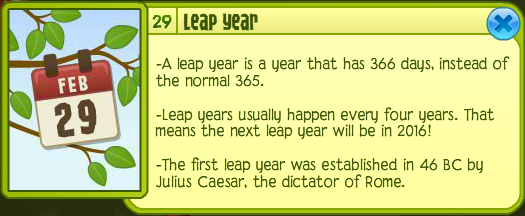
Here is some good news for those that need an extra day to catch up on sleep or to finish an assignment — 2016 is a leap year. This event that occurs every four years means that instead of the standard 365 days, the year will have 366 days. Since the extra day is tacked onto the shortest month of the year, February will have 29 days!
The extra day is not because the earth is suddenly taking longer to revolve around the sun, but to balance out the fractional time difference between our calendar and the solar calendar. As you may or may not know, our typical 365-day year is based on the time it takes our planet to get around the sun. However, that number is approximate. In reality, it takes the earth 365 days, 5 hours, 49 minutes and 16 seconds to complete the orbit.
Adding the odd number of hours to our annual year would make for a strange day. But ignoring the extra time is not a good idea either. That's because the extra quarter day each year, adds up to a full 25 days every century. This means that while our calendar year Summer would begin in June, the solar year Summer would commence a month later! If left unchecked, our calendar would be completely out of sync with the solar calendar.

Hence, in 46 B.C. Roman Emperor Julius Caesar and his team of astronomers came up with an ingenious idea. They rounded up the extra time to six hours and then added a day to the calendar every four years.
While this was a brilliant idea, it resulted in another dilemma. Rounding the 5 hours 49 mins and 16 seconds to six hours, added extra time to the day every four years. Though it is just a few minutes, over time it adds up. To rectify that Pope Gregory XIII's astronomers devised another clever, albeit confusing rule.
They proclaimed that leap year would occur every year whose number is perfectly divisible by four — except for years that are both — divisible by 100 and not divisible by 400! This means that 1700, 1800 and 1900 were not leap years but 1600, and 2000 were! Thanks to this rule, every four hundred years there are three times when leap years occur at an interval of eight years instead of the usual four! The next time this will happen is between the years 2096 and 2104.

If you are confused by this, think of the 200,000 people in the US and the over 5 million worldwide, that are born on leap day. Not only do 'leaplings' get to celebrate their birthday once every four years and in some cases every eight years, but they also have a hard time registering online for things like e-mail accounts because most programs don't recognize February 29th as a legitimate date!
Happy leap day to all of you and a very very Happy Birthday to anyone that is born on this extra special day. Be sure to let us know, if you amongst them.
Resources: wikipedia.org.,edu.sky